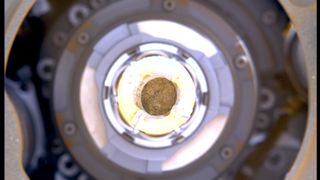
NASA’s Perseverance Mars rover has collected a bit of air along with the rock samples plucked from the Red Planet surface, which may offer valuable insight on the planet’s ancient past.
(Image credit: NASA/JPL-Caltech/ASU/MSSS)
Scientists are interested in more than just the rocks NASA’s Perseverance rover has cached throughout its trek across Mars. They want the air, too.
Since landing on Mars in 2021, Perseverance has collected 24 samples of Martian rock and dust, also known as regolith. These rock cores are believed to hold insight about the planet’s ancient past and whether life ever existed on Mars, but the air sealed inside the sample tubes could prove just as important. Scientists think this fresh Red Planet air could reveal new clues about the Martian atmosphere, too.
“The air samples from Mars would tell us not just about the current climate and atmosphere, but how it’s changed over time,” Brandi Carrier, a planetary scientist at NASA’s Jet Propulsion Laboratory in Southern California, said in a statement. “It will help us understand how climates different from our own evolve.”
The samples are sealed in titanium tubes that allow for “headspace,” or air in the extra room around the rocky material, providing scientists an opportunity to study the interaction between the Martian atmosphere and the planet’s surface.
Related: Perseverance Mars rover stashes final sample, completing Red Planet depot
The headspace may also reveal trace gases in the Martian atmosphere — which is composed mostly of carbon dioxide but may also contain small amounts of other gases dating back to the planet’s formation — and lend valuable insight on the size and toxicity of dust particles, from which scientists can better assess the risk for future crewed missions to Mars.
“The gas samples have a lot to offer Mars scientists,” Justin Simon, a geochemist at NASA’s Johnson Space Center in Houston, Texas, said in the statement. Simon is part of a group of over a dozen international experts that helps decide which samples the rover should collect.
Sign up to our newsletter for the latest updates on rocket launches, skywatching events and more!
“Even scientists who don’t study Mars would be interested because it will shed light on how planets form and evolve,” Simon said.
The samples are being collected and stored for eventual delivery to Earth as part of the Mars Sample Return campaign. However, it will be many years before the samples are opened and analyzed by scientists in laboratories on Earth, given the cost and complexity of a sample return mission. That’s why NASA recently called for a simpler and quicker approach to bring the samples home. When, or if, the samples are returned to Earth, scientists would extract the gas into a cold trap, where it would be condensed into a solid or liquid. A similar process was used to study air captured in samples collected from the moon during the Apollo 17 mission.
With the Mars samples, researchers also hope to better understand how much water vapor hovers near the Martian surface, and, in turn, why ice forms where it does on the planet. Water vapor captured in the air samples may also shed light on how Mars’ water cycle has evolved over time.
Join our Space Forums to keep talking space on the latest missions, night sky and more! And if you have a news tip, correction or comment, let us know at: [email protected].
Samantha Mathewson joined Space.com as an intern in the summer of 2016. She received a B.A. in Journalism and Environmental Science at the University of New Haven, in Connecticut. Previously, her work has been published in Nature World News. When not writing or reading about science, Samantha enjoys traveling to new places and taking photos! You can follow her on Twitter @Sam_Ashley13.
>>> Read full article>>>
Copyright for syndicated content belongs to the linked Source : Space.com – https://www.space.com/air-sealed-perseverance-mars-rover-sample-tubes































